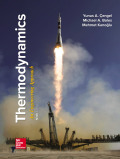
Concept explainers
Determine the enthalpy change and the entropy change of oxygen per unit mole as it undergoes a change of state from 220 K and 5 MPa to 300 K and 10 MPa (a) by assuming ideal-gas behavior and (b) by accounting for the deviation from ideal-gas behavior.
(a)
The change in specific enthalpy and entropy of oxygen per unit mole by assuming ideal-gas behavior.
Answer to Problem 73P
The change in specific enthalpy and entropy of oxygen per unit mole by assuming ideal-gas behavior is
Explanation of Solution
At ideal gas state, the enthalpy is the function of temperature only.
Write the formula for difference in molar specific enthalpy of oxygen at ideal gas state.
Here, the molar enthalpy at ideal gas state corresponding to the temperature is
Write the formula for change in molar specific entropy.
Here, the molar specific entropy at reference sate is
Refer Table A-19, “Ideal-gas properties of oxygen,
Obtain the initial properties corresponding to the temperature of
Obtain the final properties corresponding to the temperature of
The universal gas constant
Conclusion:
Substitute
Substitute
Thus, the change in specific enthalpy and entropy of oxygen per unit mole by assuming ideal-gas behavior is
(b)
The change in specific enthalpy and entropy of oxygen per unit mole by accounting for the deviation from ideal-gas behavior.
Answer to Problem 73P
The change in specific enthalpy and entropy of oxygen per unit mole by accounting for the deviation from ideal-gas behavior is
Explanation of Solution
Write formula for enthalpy departure factor
Here, the molar enthalpy at ideal gas state is
Rearrange the Equation (III) to obtain
Refer Equation (IV) express as two states of enthalpy difference (final – initial).
Write formula for entropy departure factor
Here, the molar entropy at ideal gas state is
Rearrange the Equation (VI) to obtain
Refer Equation (VII) express as two states of entropy difference (final – initial).
Refer Table A-1, “Molar mass, gas constant, and critical-point properties”.
The critical temperature and pressure of oxygen gas is as follows.
The reduced pressure
The reduced pressure
At initial:
Refer Figure A-29, “Generalized enthalpy departure chart”.
The enthalpy departure factor
Refer Figure A-30, “Generalized entropy departure chart”.
The entropy departure factor
At final:
Refer Figure A-29, “Generalized enthalpy departure chart”.
The enthalpy departure factor
Refer Figure A-30, “Generalized entropy departure chart”.
The entropy departure factor
Conclusion:
Substitute
Substitute
Thus, the change in specific enthalpy and entropy of oxygen per unit mole by accounting for the deviation from ideal-gas behavior is
Want to see more full solutions like this?
Chapter 12 Solutions
EBK THERMODYNAMICS: AN ENGINEERING APPR
- The tooth numbers for the gear train illustrated are N₂ = 24, N3 = 18, №4 = 30, №6 = 36, and N₁ = 54. Gear 7 is fixed. If shaft b is turned through 5 revolutions, how many turns will shaft a make? a 5 [6] barrow_forwardCE-112 please solve this problem step by step and give me the correct answerarrow_forwardCE-112 please solve this problem step by step and give me the correct answerarrow_forward
- CE-112 solve this problem step by step and give me the correct answer pleasearrow_forwardPlease do not use any AI tools to solve this question. I need a fully manual, step-by-step solution with clear explanations, as if it were done by a human tutor. No AI-generated responses, please.arrow_forwardPlease do not use any AI tools to solve this question. I need a fully manual, step-by-step solution with clear explanations, as if it were done by a human tutor. No AI-generated responses, please.arrow_forward
 Refrigeration and Air Conditioning Technology (Mi...Mechanical EngineeringISBN:9781305578296Author:John Tomczyk, Eugene Silberstein, Bill Whitman, Bill JohnsonPublisher:Cengage Learning
Refrigeration and Air Conditioning Technology (Mi...Mechanical EngineeringISBN:9781305578296Author:John Tomczyk, Eugene Silberstein, Bill Whitman, Bill JohnsonPublisher:Cengage Learning Principles of Heat Transfer (Activate Learning wi...Mechanical EngineeringISBN:9781305387102Author:Kreith, Frank; Manglik, Raj M.Publisher:Cengage Learning
Principles of Heat Transfer (Activate Learning wi...Mechanical EngineeringISBN:9781305387102Author:Kreith, Frank; Manglik, Raj M.Publisher:Cengage Learning Automotive Technology: A Systems Approach (MindTa...Mechanical EngineeringISBN:9781133612315Author:Jack Erjavec, Rob ThompsonPublisher:Cengage Learning
Automotive Technology: A Systems Approach (MindTa...Mechanical EngineeringISBN:9781133612315Author:Jack Erjavec, Rob ThompsonPublisher:Cengage Learning Welding: Principles and Applications (MindTap Cou...Mechanical EngineeringISBN:9781305494695Author:Larry JeffusPublisher:Cengage Learning
Welding: Principles and Applications (MindTap Cou...Mechanical EngineeringISBN:9781305494695Author:Larry JeffusPublisher:Cengage Learning



